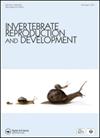Cellular defence and innate immunity in the larval ovarian disc and differentiated ovariole of the silkworm Bombyx mori induced by microsporidian infection
IF 0.8
4区 生物学
Q4 REPRODUCTIVE BIOLOGY
引用次数: 4
Abstract
ABSTRACT Activation of cellular defence and immunity in the ovary is critical to protect it from pathogenic infection. In this study cellular and innate immunity in larval and pupal ovaries of Bombyx mori induced by the microsporidian Nosema bombycis is reported. Autophagic vacuoles enclosing spores in flat cells of the larval ovarian disc revealed cellular defence. In the follicular epithelium of differentiated previtellogenic ovarioles of infected pupae, a network of RER and phagosomes observed probably to maintain cellular homeostasis. In larval and pupal ovaries, paralytic peptide titre, tyrosine content and phenoloxidase activity were enhanced revealing greater melanisation, which was confirmed by activation of melanisation genes, DDC, prophenoloxidase activating enzyme, prophenoloxidase 1 (PPO1) and PPO2 after infection. βGRP-2, βGRP-4, CTL-11, Humoral lectin, Toll-6, Spätzle, Cactus, Relish, Pelle, and Dorsal genes showed differential expression in infected larval and pupal ovaries. Pupal ovarioles showed decreased expression and lower Spätzle titre than the larval ovary revealing suppression of innate immunity in the pupal ovary. Dorsal showed decreased expression, however, Pelle enhanced expression to maintain immunity through alternate components in differentiated ovarioles. Our data showed that coupled with cellular defence reactions, innate immune reactions and melanisation are activated in the developing ovary to defend against N. bombycis infection.微孢子虫感染诱导家蚕幼虫卵巢盘和分化卵巢的细胞防御和先天免疫
卵巢细胞防御和免疫的激活是保护其免受致病性感染的关键。本文报道了家蚕微孢子虫(Nosema bombycis)诱导家蚕幼虫和蛹子房的细胞免疫和先天免疫。卵盘扁平细胞内包裹孢子的自噬液泡显示细胞防御。在受感染的蛹分化的卵泡前卵巢的卵泡上皮中,观察到内质网和吞噬体的网络可能维持细胞稳态。在感染后,麻痹肽滴度、酪氨酸含量和酚氧化酶活性均升高,表明黑化程度更高,黑化基因、DDC、酚氧化酶原活化酶、酚氧化酶原1 (PPO1)和PPO2的激活证实了这一点。βGRP-2、βGRP-4、CTL-11、唾液凝集素、Toll-6、Spätzle、Cactus、flavor、Pelle和Dorsal基因在感染的幼虫和蛹的卵巢中有差异表达。蛹卵巢表达降低,Spätzle滴度低于幼虫卵巢,表明蛹卵巢先天免疫受到抑制。在分化的卵巢中,背侧表达降低,而小柱表达增强,通过交替组分维持免疫。我们的数据表明,结合细胞防御反应,先天免疫反应和黑色素化在发育中的卵巢中被激活,以防御瓢虫感染。
本文章由计算机程序翻译,如有差异,请以英文原文为准。
求助全文
约1分钟内获得全文
求助全文
来源期刊
CiteScore
1.90
自引率
0.00%
发文量
21
审稿时长
>12 weeks
期刊介绍:
Invertebrate Reproduction & Development ( IRD) presents original research on the reproductive and developmental biology of the Invertebrata, both embryonic and postembryonic. IRD welcomes papers reporting significant results obtained using new techniques. Encouraged topic areas include: aquaculture, physiology, biochemistry, functional morphology, phylogeny, behavioural and regulatory mechanisms, including genetic, endocrine and molecular studies. Papers containing qualitative descriptions of reproductive cycles and gametogenesis will not be considered. IRD is published in association with the International Society of Invertebrate Reproduction and Development.

 求助内容:
求助内容: 应助结果提醒方式:
应助结果提醒方式:


